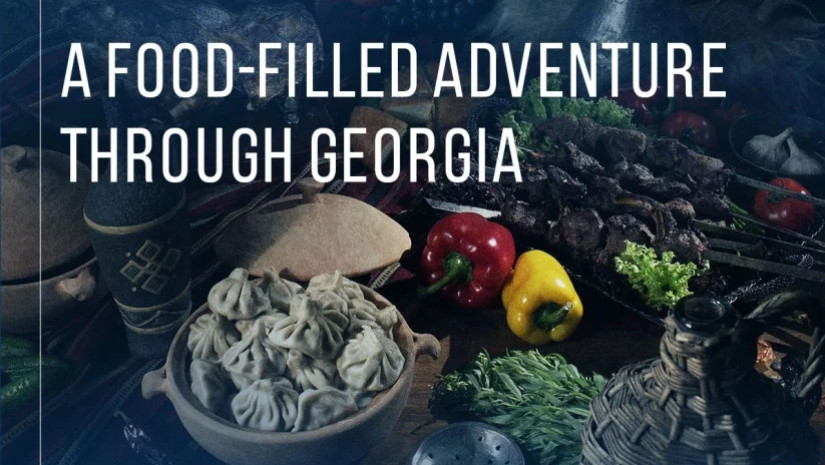Two professional foodies tuck into Georgia’s best dishes and discover a cuisine that can hold its own on the world stage.
Ben Ebbrell and Jamie Spafford are two of YouTube’s most popular food and drink content creators. Their Sorted Food channel, which sees them taking on culinary challenges around the world, has 2.7 million subscribers.
Although they’ve tackled a wide range of national cuisines and regional styles, Georgia is one part of the world they’ve not yet visited. “We’ve been doing this on YouTube for 13 years,” says Ben, “and if my memory serves me right, we’ve only discussed Georgian cuisine once across hundreds of videos.”
It’s time to put that right. We asked the Sorted Food team to get to know the country through the restaurants, chefs and culinary traditions that have made Georgia an in-the-know destination for gastronomes.
In lots of ways, Ben and Jamie are typical of Western visitors heading to the Caucasus for the first time.
“I could probably pinpoint the country on a map,” says Jamie. “I know it’s very old. I know it’s incredibly traditional in a lot of ways, and I know there’s a good intersection between that and the more modern side of the city of Tbilisi. But other than that, I’m a complete newbie when it comes to Georgia.”
Smaller than Austria or Ireland, Georgia isn’t a large country, which is good news if you have limited time to explore. However, there is so much to see, from historic towns, picturesque mountain villages, seaside resorts and ski slopes to Georgia’s wine-producing region.
We followed Jamie and Ben on their summer trip to sample the food, the sights and the culture. And, for visitors not on a tight filming schedule, we suggested other places to go, too.
They start in Tbilisi, where most Georgian adventures begin. The capital city is blessed with numerous vantage points, notably the monumental statue of Kartlis Deda, the “Mother of Georgia,” who surveys the city above the canopy of fir trees on Sololaki Hill. From here, Tbilisi is laid out before your eyes like a tempting feast.
David, their tour guide, meets Jamie and Ben at the remarkable Chronicle of Georgia monument. In a small, wooded area on the city’s outskirts, 16 25-meter-tall columns rise into the sky. The Chronicle of Georgia is reminiscent of Stonehenge, and the mighty carved pillars also bring to mind the ancient city of Luxor.
But this site is not ancient. Georgian sculptor Zurab Tsereteli created the work in 1985 to tell the story of his homeland—its rulers and heroes—as well as the story of Jesus.
From the terrace, you get a panoramic view of the city and, high above, the forbidding walls of the Narikala Fortress. Like the Chronicle site, it’s a good place to wrap your head around the huge span of Georgia’s history. The fortress was first constructed in the second half of the fourth century AD—but archeologists have found evidence of Bronze Age human settlement in the area from the fourth millennium BCE.
If you want to get down the hill from Narikala extra-fast, do what Jamie and Ben did, and hitch a ride on the 279-meter zipline.
Once on solid ground, our explorers meet Tekuna Gachechiladze, one of the leading innovators of contemporary Georgian cooking. Her restaurant, Cafe Littera, is in the garden of an Art Deco mansion built in 1905, known as the Writer’s House. It’s been a center of literary activity since 1923, attracting international visitors including US novelist John Steinbeck.
But by 2008, it was almost a ruin. Natasha “Nata” Lomouri painstakingly restored the house plank by plank. In 2014, she invited her friend Tekuna to start the restaurant and make Georgian food famous, reimagining dishes such as “chakapuli” by using mussels (instead of lamb or veal) in plum sauce.
After a hearty meal, and a walk around the local markets and through Tbilisi’s Old own, visitors may be ready to enjoy something to revive them. In Tbilisi, that means an invigorating trip to a spa in Abanotubani, the district famous for its hot baths and invigorating massages.
Finding the baths is easy: Look for the distinctive brick domes, standing out on the skyline like so many pizza ovens, and follow the smell of natural hydrogen sulfide. Tbilisi is built on sulfur springs, and the prefix “Tbili” means “warm.” Legend has it that a fifth-century king was so impressed by the hot springs here that he built the city of Tbilisi around them.
Suitably revived by a trip to the sulfur baths, Ben and Jamie head to Azarpesha Restaurant to try their hand at making “khinkali,” traditional meat dumplings. Owner Luarsab Togonidze offers a crash course in Georgian hospitality. Like Jamie and Ben, visitors are invited to sit down to a supra—the traditional Georgian welcoming feast—doubtless including the classic toasting ritual. There will be songs, and Jamie, whose wife is a singing teacher, is keen to try his vocal chords at some classic Georgian polyphonic singing. Luarsab sings, too.
With Tbilisi well traversed, our food explorers are keen to go beyond the capital, and they head out to explore one of Georgia’s most ancient innovations: winemaking.
September is the best time to see the harvest celebration and associated festivals, but a visit to Kakheti, the wine-producing region just east of Tbilisi, at any time of the year offers a chance to experience everything from grand French-style chateaux to humbler vineyards.
One such chateau is the home of the Tsinandali Estate. This utterly charming early 19th-century house became a center of Georgian intellectual and cultural life under Prince Alexander Chavchavadze, who imported the latest winemaking skills from Western Europe.
The estate celebrates Georgia’s 8,000 years of winemaking and the best of modern viniculture. Visitors can enjoy a five-star stay at the Radisson hotel on the property—and maybe, like Jamie and Ben, take on a breadmaking challenge.
To see the full breadth of Kakheti’s culinary production, follow in the Sorted team’s footsteps to the Telavi food market to sample Akhmeta cheese, “nadughi” (Georgian ricotta) and “matsoni” (Georgian yogurt).
To finish, take a walk around Telavi’s giant plane tree, which is 11 meters in circumference and 40 meters high. It began growing here in the shadow of the Caucasus Mountains in Georgia’s Golden Age, more than 900 years ago. It’s a fitting spot to finish any tour—like the country itself, a place of living history that continues to grow and thrive.


















